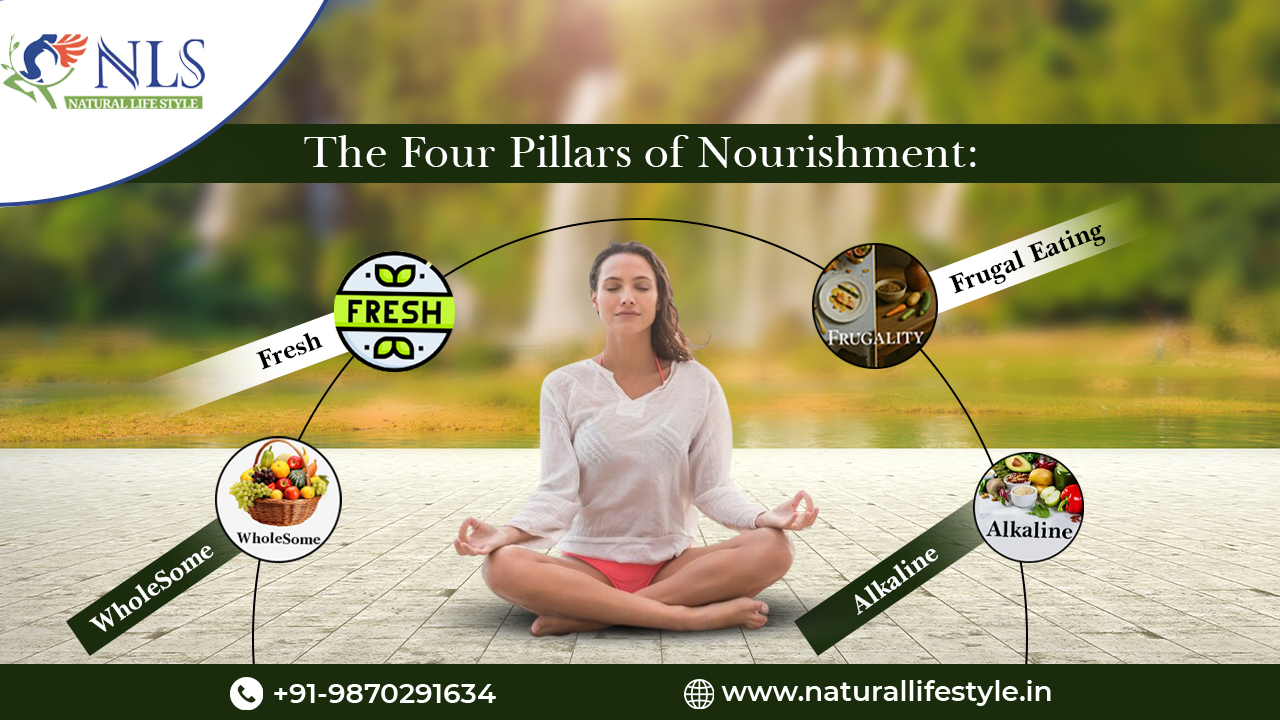
Drawing from traditional Indian wisdom and natural health principles, we can realign our food choices to support vitality, longevity, and inner balance. So in this blog, we will learn about these four pillars—Wholesomeness, Freshness, Alkalinity, and Frugality—that form the foundation of a healthful, harmonious way of eating.
Nature designs food in complete packages—rich in nutrients, fiber, and vitality. When we strip food of its natural parts, we are left with something that may look familiar but no longer nourishes the body.
Traditional wheat flour contains bran, the fibrous outer layer rich in nutrients. Unfortunately, most commercial flours remove this layer, leaving behind a pale, nutrient-deficient powder. Here’s a simple experiment:
Place two bowls of flour—one with bran and one without. Within days, you will notice worms are drawn only to the bowl with bran. Even insects know where the nourishment lies.
Refined flour is like a currency note without a serial number—visibly present but functionally void.
This loss is evident in our daily foods:
White breads, biscuits, noodles, and even traditional snacks like poori, bhatura, naan, samosa, and jalebi are now made with refined flour, lacking in life and substance. Similarly, the white rice we consume is polished, stripped of its nutrient-rich outer layer for the sake of appearance.
Years ago in the United States, widespread health issues were linked to white bread consumption. In response, public health campaigns coined the phrase:
“The whiter the bread, the sooner you’re dead.”
Americans switched to brown bread, while ironically, we in India adopted their earlier habits—embracing whiteness over wellness.
Sugarcane in its natural form is highly nutritious. When converted into jaggery or desi khand, many nutrients are retained. But once it becomes white sugar, the essential minerals like iron and calcium are lost. White sugar not only lacks nourishment—it actively depletes calcium from our body, weakening teeth, bones, and kidneys.
As mentioned in Sri Guru Granth Sahib Ji (Page 1388):
“Khaan paan meetha ras bhojan ant kee baar hot kaat khaari”
“Sweet and rich foods may satisfy the tongue, but they cut away at life itself”
(Page 1387):
“Khaan paan sodhai sukh bhuchat sankat kaat vipat hari”
“By improving your food, you rid yourself of suffering and disease.”
A freshly plucked fruit, like a guava straight from the tree, carries an energy that no cold storage item can match. While attached to its plant, a fruit remains in contact with the sun, earth, and air—the very sources of life. Once plucked, its nutritional value begins to degrade.
Seasonal, local, and fresh produce are naturally more nutritious, affordable, and aligned with our bodies’ needs. Freshness is not a luxury—it is a principle of nature.
If you want to feel light and fresh, you must eat light and fresh.
Eating unseasonal fruits and vegetables—especially imported ones—is a trend driven by marketing, not by health. For instance, sweet fruits like mango, papaya, or watermelon are grown in North India during the summer, when the body can handle the extra sugar. In winter, however, these fruits can tax our digestive system.
Winter brings its bounty: guava, citrus, radishes, carrots, spinach, mustard, and turnips. These require less vital force to digest and help balance our inner heat with the cold outside.
Compare this to stimulants like tea or coffee, which offer short-term warmth but disrupt the internal temperature balance, eventually making us feel colder.
Coconut is nature’s perfect food—immune to pesticides, resistant to decay, and usable in multiple forms. Ancient texts even describe coconut as Shree Phal, the sacred fruit born of the divine churning of the ocean.
Rich in unsaturated fats and entirely cholesterol-free in its raw form, coconut benefits people of every age, season, and health condition. It is nature’s nectar.
Human health thrives in an alkaline environment. Our bodies, like the Earth, are 70% water and 30% solid. To maintain this internal harmony, our diet should reflect the same ratio—70% water-rich, alkaline foods and 30% denser, acidic foods like grains and pulses.
When the body becomes too acidic, its natural balance is disturbed. Bones stiffen, energy depletes, and chronic illnesses arise:
Diabetes, arthritis, blood pressure issues, asthma, joint pain, and even cancer.
Avoid starchy tubers (arbi, jimikand, and potatoes), as they are heavy and acidic.
Adding lemon to salads or meals, though common, can turn otherwise alkaline foods acidic. Instead, lemon can be used occasionally in drinks like shikanji during illness or fatigue.
Use crushed gooseberry (amla) in salads or its juice with jaggery or desi khand.
Fruits like watermelon, muskmelon, citrus, pomegranate, and jamun are alkaline and hydrating. But avoid over-consuming sweet or chemically ripened fruits such as bananas, mangoes, grapes, and papaya.
Be cautious with apples from cold storage. If possible, opt for seasonal golden apples, which are less chemically treated.
The final pillar is not about what we eat but how much.
Overeating—even the healthiest food—can lead to disease. The body does not function like a bank that stores excess nutrition for future use. Instead, excess burdens the digestive system, weakens organs, and depletes energy.
As Fareed Ji humbly says in Sri Guru Granth Sahib Ji (Page 1379):
“Fareeda roti meri kaath ki, laavan meri bhookh;
Jitni khaadhi chhup rahi, ghane sahenge dukh.”
“Let my hunger be satisfied with simple food, for rich and oily meals lead to suffering.”
In today’s world, we are drawn to shiny, well-packaged food products. But true nourishment lies in simplicity and authenticity.